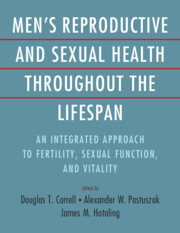 Men's Reproductive and Sexual Health Throughout the Lifespan
Men's Reproductive and Sexual Health Throughout the Lifespan Book contents
- Men’s Reproductive and Sexual Health throughout the Lifespan
- Men’s Reproductive and Sexual Health throughout the Lifespan
- Copyright page
- Contents
- Contributors
- Preface
- Section 1 An Introduction to Men’s Health Care
- Section 2 The Biology of Male Reproduction and Infertility
- Section 3 Clinical Evaluation and Treatment of Male Infertility
- Section 4 Laboratory Evaluation and Treatment of Male Infertility
- Section 5 Medical and Surgical Management of Issues of Male Health
- Chapter 32 Hypogonadism in the Male
- Chapter 33 Selective Androgen Receptor Modulators in the Treatment of Hypogonadism and Men’s Health
- Chapter 34 Male Fertility and Testosterone Therapy
- Chapter 35 Sleep and Men’s Health
- Chapter 36 Molecular Biology and Physiology of Erectile Function and Dysfunction
- Chapter 37 Evaluation of the Male with Erectile Dysfunction
- Chapter 38 Lifestyle Modifications for Erectile Dysfunction
- Chapter 39 Medical and Surgical Management of Erectile Dysfunction
- Chapter 40 Surgical Management of Peyronie’s Disease
- Chapter 41 Medical Management of Benign Prostatic Hyperplasia
- Chapter 42 Evidence-Based Management of Chronic Orchialgia and Chronic Prostatitis/Chronic Pelvic Pain Syndrome
- Index
- References
Chapter 32 - Hypogonadism in the Male
Evaluation and Treatment
from Section 5 - Medical and Surgical Management of Issues of Male Health
Published online by Cambridge University Press: 06 December 2023
- Men’s Reproductive and Sexual Health throughout the Lifespan
- Men’s Reproductive and Sexual Health throughout the Lifespan
- Copyright page
- Contents
- Contributors
- Preface
- Section 1 An Introduction to Men’s Health Care
- Section 2 The Biology of Male Reproduction and Infertility
- Section 3 Clinical Evaluation and Treatment of Male Infertility
- Section 4 Laboratory Evaluation and Treatment of Male Infertility
- Section 5 Medical and Surgical Management of Issues of Male Health
- Chapter 32 Hypogonadism in the Male
- Chapter 33 Selective Androgen Receptor Modulators in the Treatment of Hypogonadism and Men’s Health
- Chapter 34 Male Fertility and Testosterone Therapy
- Chapter 35 Sleep and Men’s Health
- Chapter 36 Molecular Biology and Physiology of Erectile Function and Dysfunction
- Chapter 37 Evaluation of the Male with Erectile Dysfunction
- Chapter 38 Lifestyle Modifications for Erectile Dysfunction
- Chapter 39 Medical and Surgical Management of Erectile Dysfunction
- Chapter 40 Surgical Management of Peyronie’s Disease
- Chapter 41 Medical Management of Benign Prostatic Hyperplasia
- Chapter 42 Evidence-Based Management of Chronic Orchialgia and Chronic Prostatitis/Chronic Pelvic Pain Syndrome
- Index
- References
Summary
Knowledge of the anatomy and physiology of the hypothalamic-pituitary-gonadal axis is paramount for the understanding and management of hypogonadism in men. Although the definition of hypogonadism may seem elusive, there is a framework to assist with the diagnosis once a history, physical examination, and appropriate lab testing are obtained. There are a number of treatment options to consider with their associated risks and benefits.
- Type
- Chapter
- Information
- Men's Reproductive and Sexual Health Throughout the LifespanAn Integrated Approach to Fertility, Sexual Function, and Vitality, pp. 251 - 263Publisher: Cambridge University PressPrint publication year: 2023
